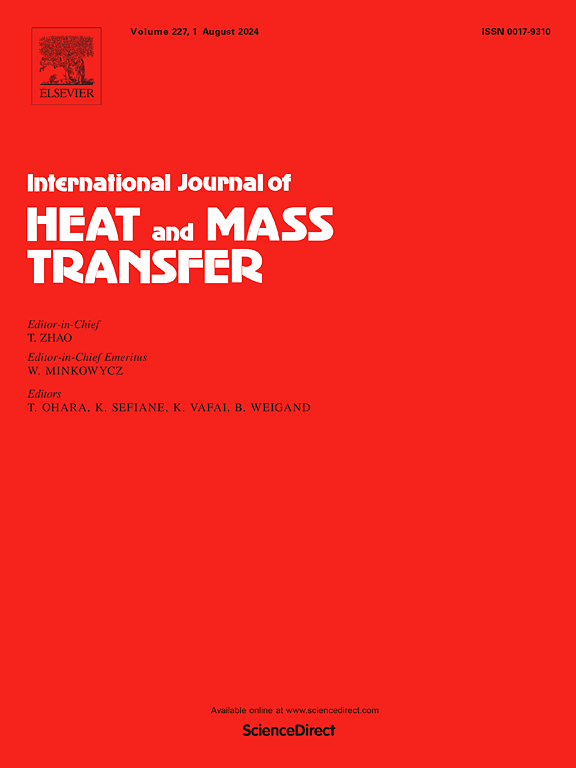SiC/ mo基涂层激光熔覆熔池流动及显微组织演变
IF 5
2区 工程技术
Q1 ENGINEERING, MECHANICAL
International Journal of Heat and Mass Transfer
Pub Date : 2025-07-05
DOI:10.1016/j.ijheatmasstransfer.2025.127482
引用次数: 0
摘要
熔池流动和微观组织对涂层形貌和性能的影响具有重要的研究价值。然而,目前对激光熔覆过程中传热、流动行为和晶粒演化之间的多尺度耦合机制缺乏系统的研究,特别是对非等温条件下的协同效应认识不足。本文采用多相耦合数值模型结合元胞自动机(CA)模型,研究了激光熔覆过程中非等温流动和微观组织演变的机理。实验结果验证了所建立的激光熔覆过程中宏观传热与流动耦合多相模型的有效性。基于多相耦合模型,分析了熔池内的传热和流动行为,揭示了温度与流速的相互作用机理。进一步研究了熔池凝固过程中胞状、柱状和等轴晶的演变,定量分析了凝固参数(G, R)和复合参数(G*R, G/R)。枝晶生长结果表明,在柱状晶生长过程中,相邻晶粒之间的溶质浓度不断增加,导致微偏析;而在熔池顶部,与等轴晶生长相关的重叠溶质堆积区抑制了枝晶的生长。研究发现,过冷形核现象的主要原因是凝固过程中生长速度的增加,从而改变了固液界面的温度梯度。这种变化导致组分过冷,最终导致柱状晶向等轴晶转变。SiC/ mo基涂层显著提高了IN718合金的显微硬度和耐磨性。该研究为预测激光熔覆过程的微观组织演变提供了理论基础。本文章由计算机程序翻译,如有差异,请以英文原文为准。
Molten pool flow and microstructure evolution in laser cladding of SiC/Mo-based coating
The influence of melt pool flow and microstructure on coating morphology and performance is of significant research value. However, there is currently a lack of systematic research on the multi-scale coupling mechanism between heat transfer, flow behavior, and grain evolution during the laser cladding process, especially the insufficient understanding of the synergistic effect under non-isothermal conditions. In this study, a multiphase coupled numerical model combined with a cellular automaton (CA) model is employed to investigate the mechanisms underlying non-isothermal flow and microstructural evolution during the laser cladding process. Experimental results validate the effectiveness of the developed multiphase model that couples macroscopic heat transfer and flow in laser cladding. Based on the multiphase coupled model, the heat transfer and flow behavior within the melt pool were analyzed, revealing the interaction mechanisms between temperature and flow velocity. The evolution of cellular, columnar, and equiaxed crystals during the solidification of the molten pool was further investigated, and the solidification parameters (G, R), as well as the composite parameters (G*R, G/R) were quantitatively analyzed. Dendritic growth results indicate that during columnar crystal growth, the solute concentration between adjacent grains continuously increases, leading to microsegregation; whereas at the top of the melt pool, the overlapping solute accumulation zones associated with equiaxed crystal growth inhibit dendritic growth. The study identified that the primary cause of the undercooling nucleation phenomenon is the increased growth rate during solidification, which alters the temperature gradient at the solid-liquid interface. This change leads to the undercooling of the composition and ultimately results in the transformation from columnar to equiaxed crystals (CET). The SiC/Mo-based coating significantly enhances the microhardness and wear resistance of IN718 alloy. This study provides a theoretical foundation for predicting microstructural evolution in carbide-coated laser cladding processes.
求助全文
通过发布文献求助,成功后即可免费获取论文全文。
去求助
来源期刊
CiteScore
10.30
自引率
13.50%
发文量
1319
审稿时长
41 days
期刊介绍:
International Journal of Heat and Mass Transfer is the vehicle for the exchange of basic ideas in heat and mass transfer between research workers and engineers throughout the world. It focuses on both analytical and experimental research, with an emphasis on contributions which increase the basic understanding of transfer processes and their application to engineering problems.
Topics include:
-New methods of measuring and/or correlating transport-property data
-Energy engineering
-Environmental applications of heat and/or mass transfer

 求助内容:
求助内容: 应助结果提醒方式:
应助结果提醒方式:


